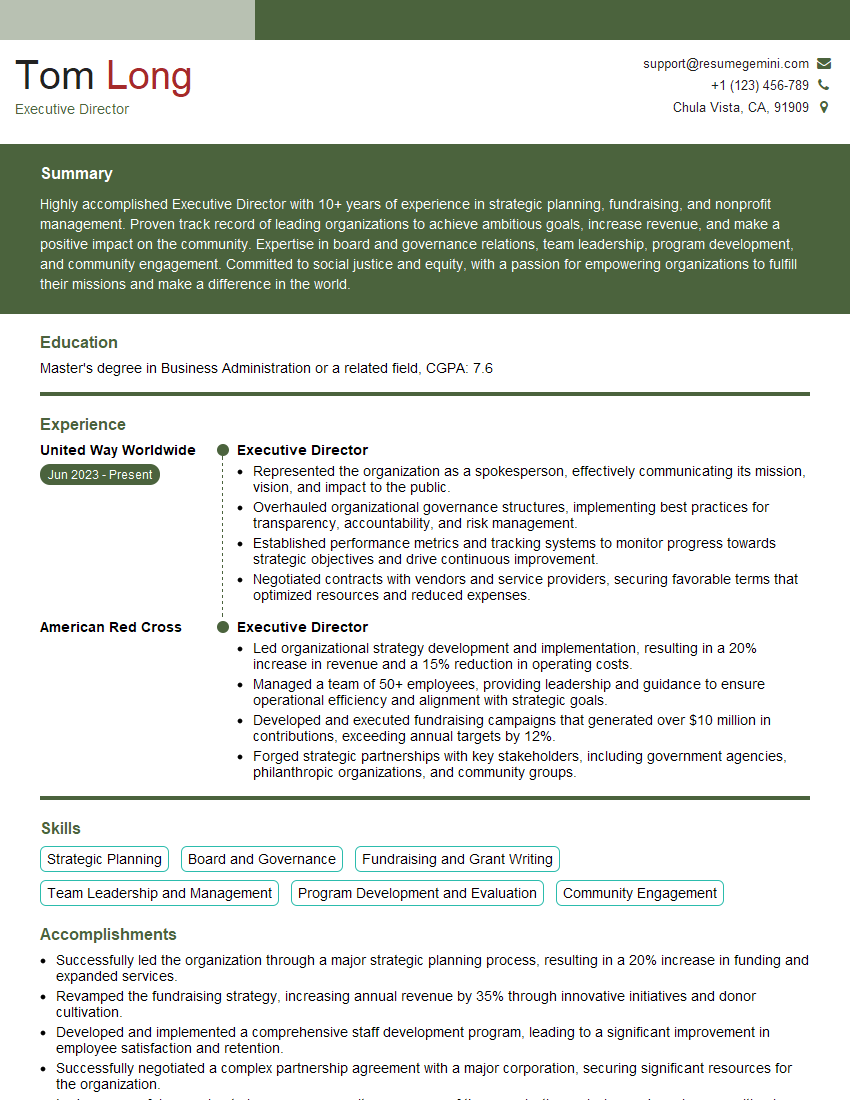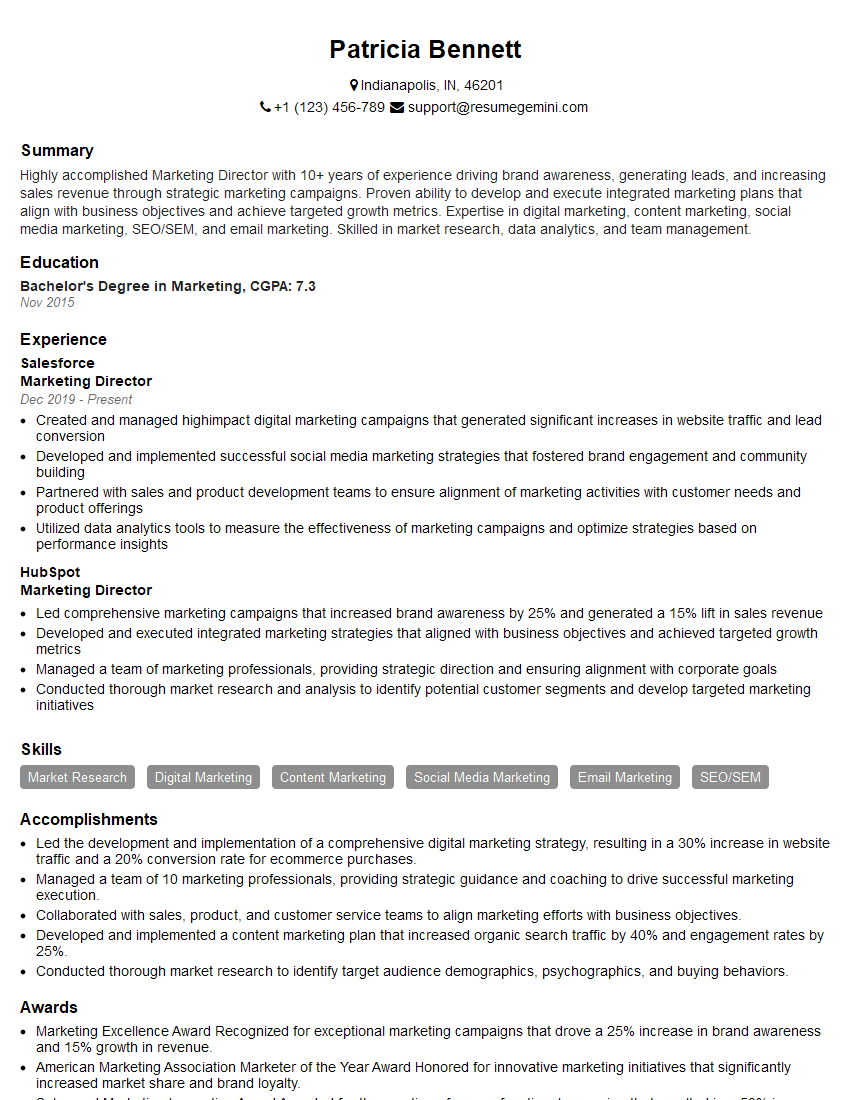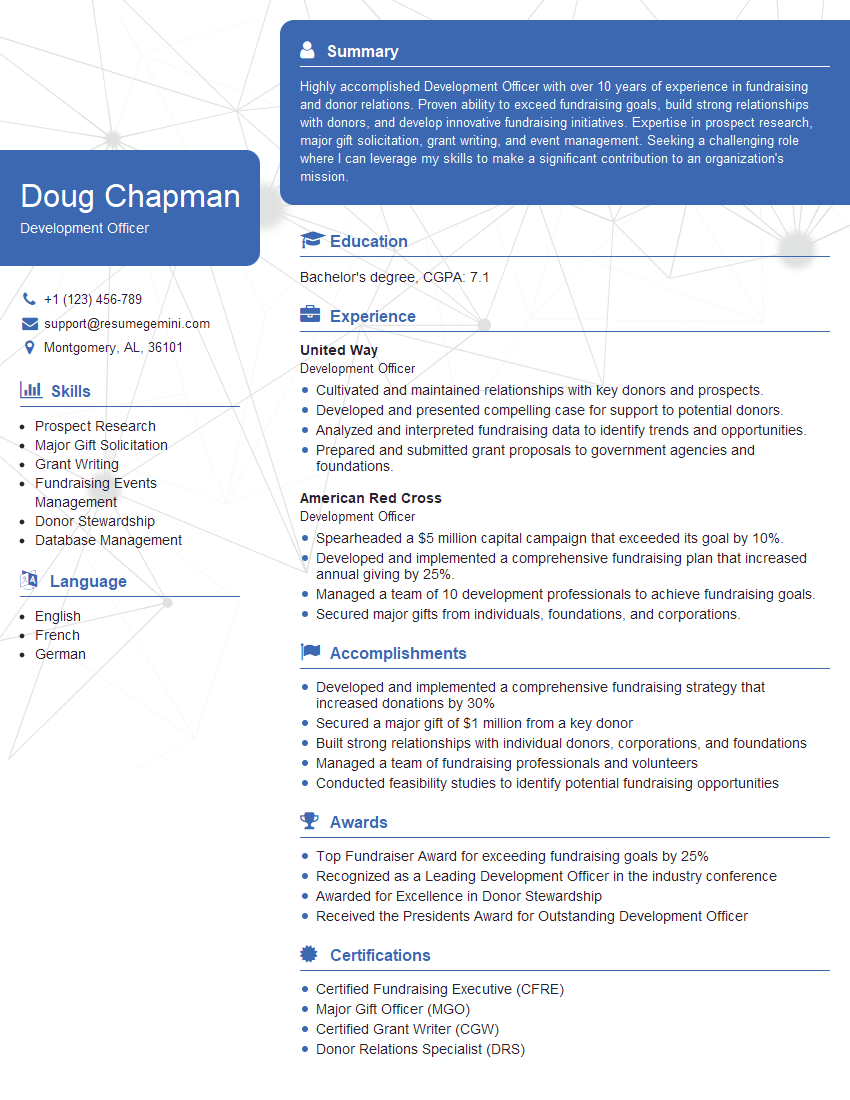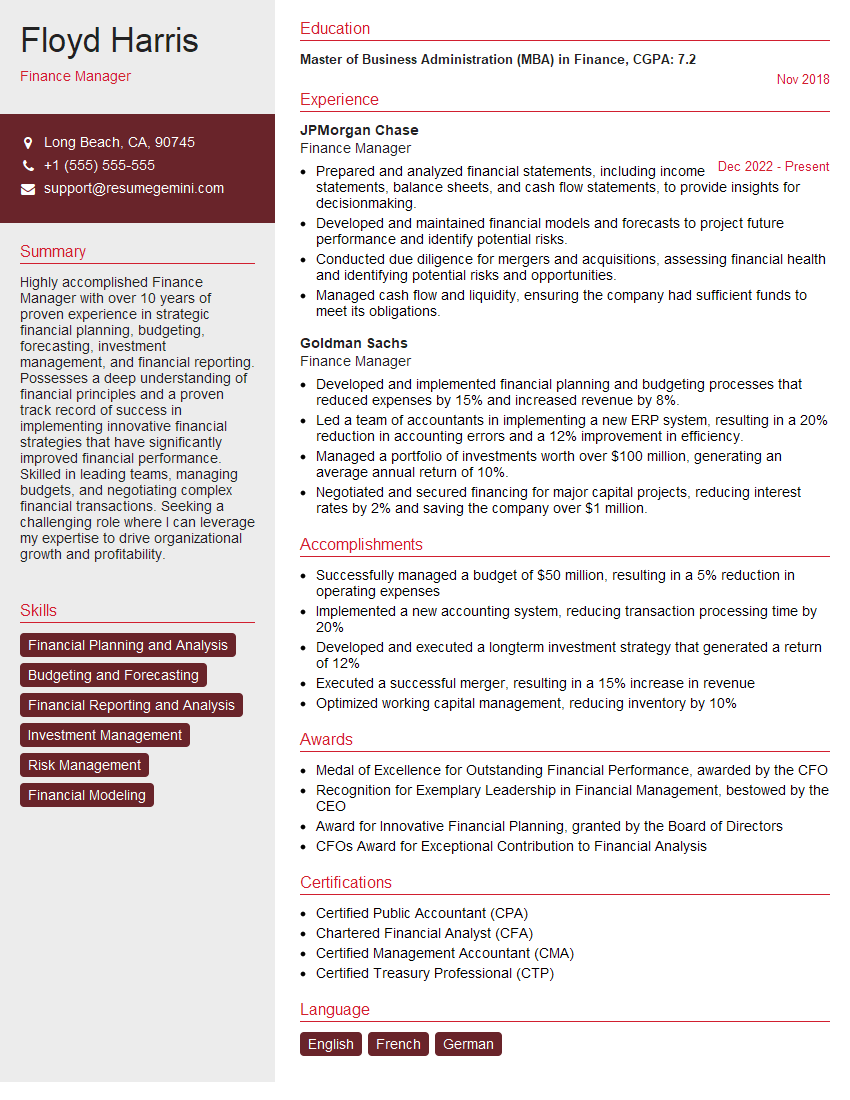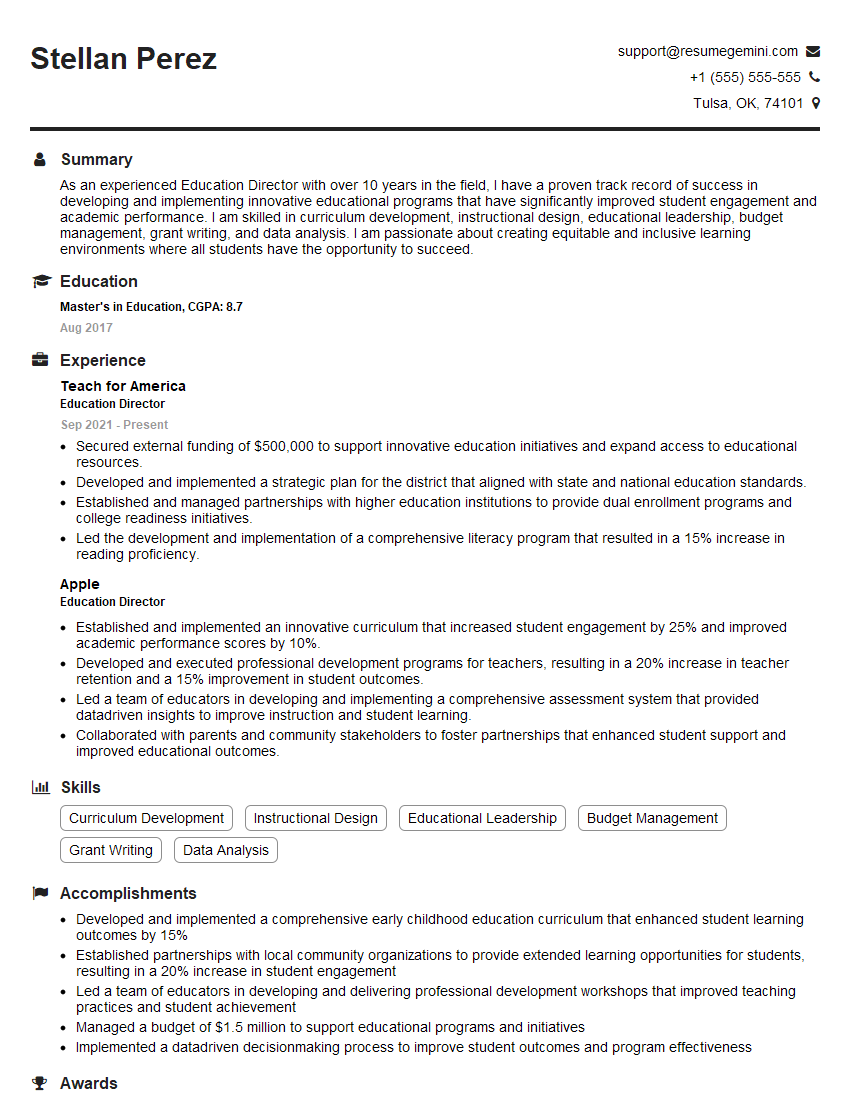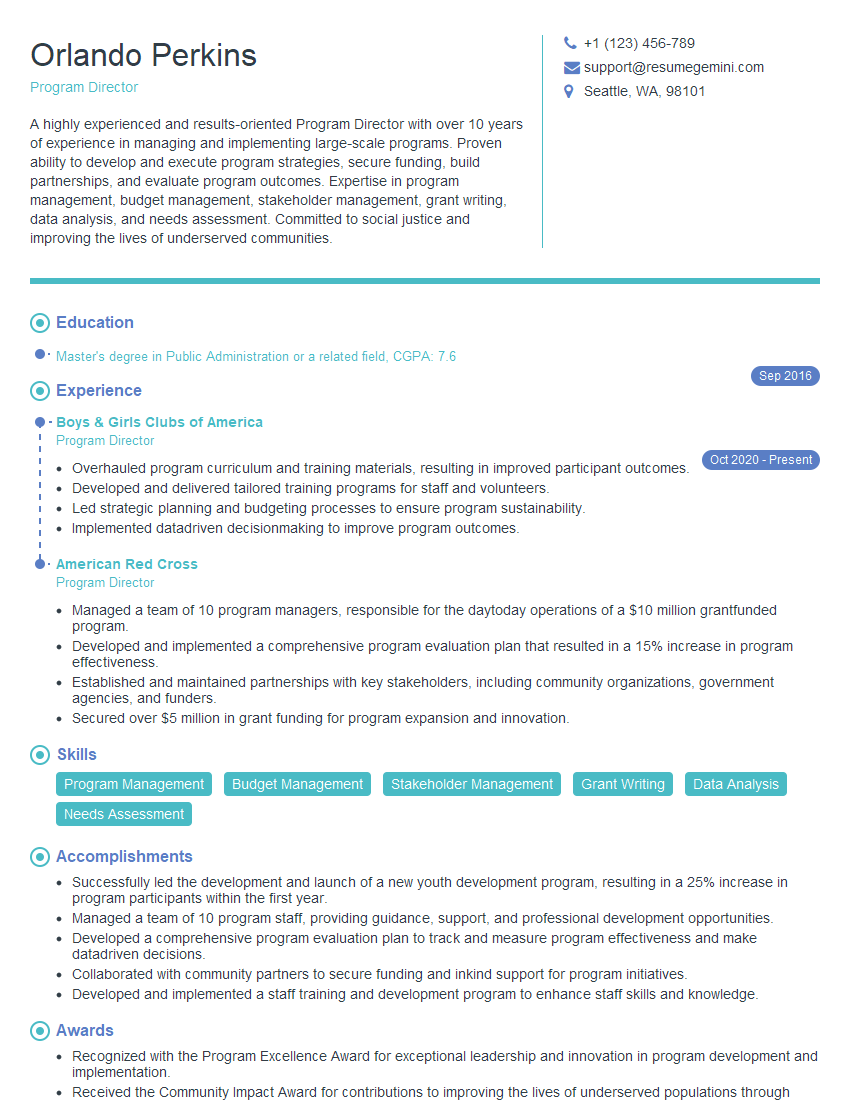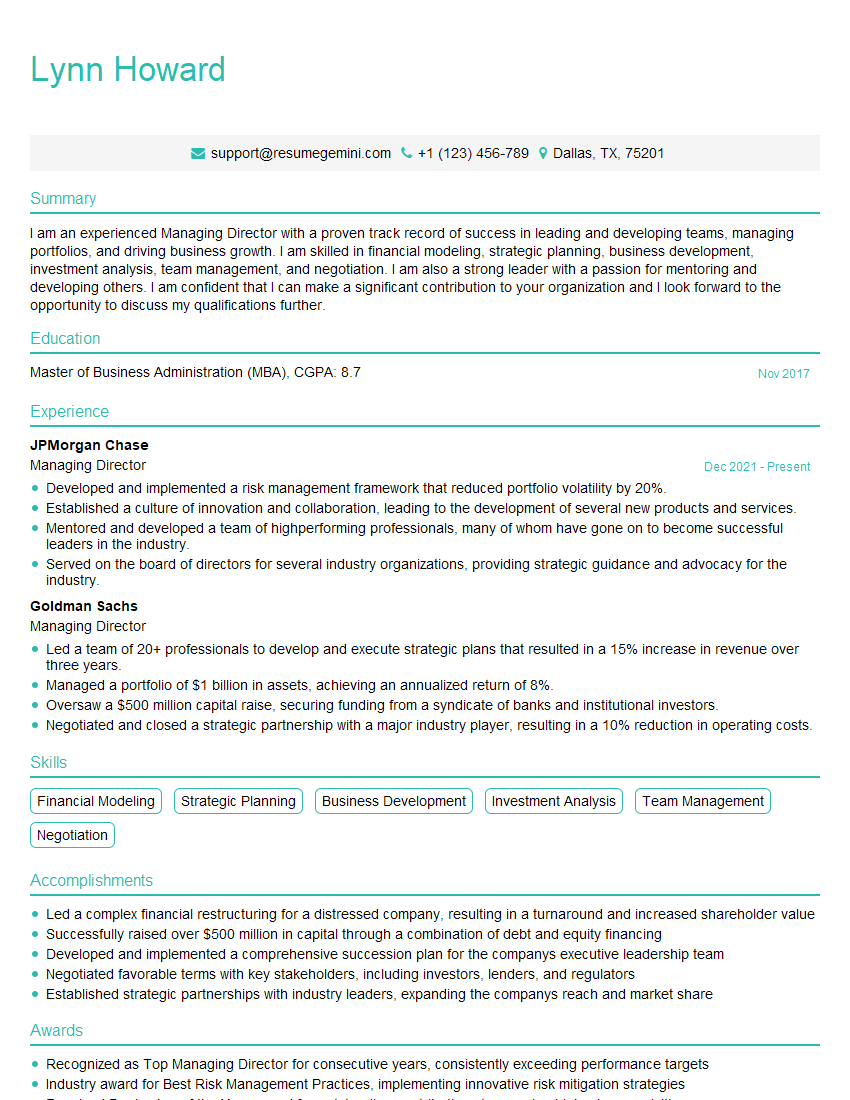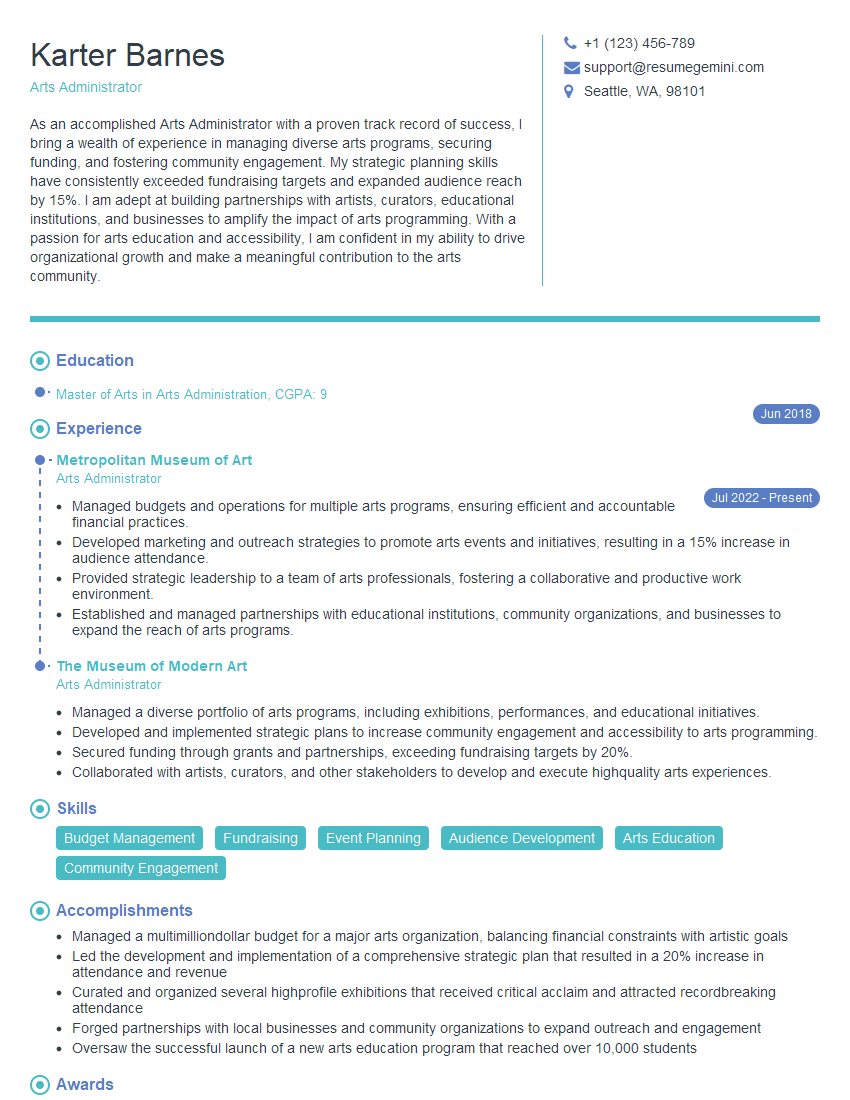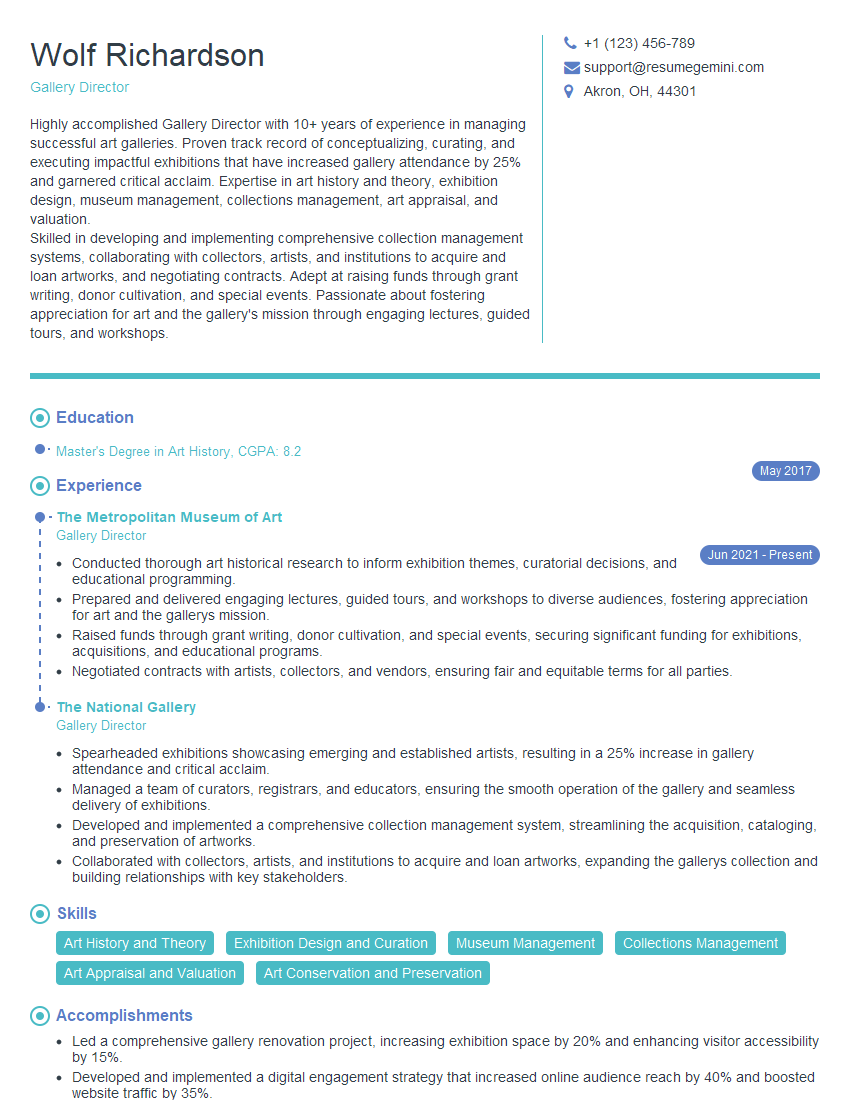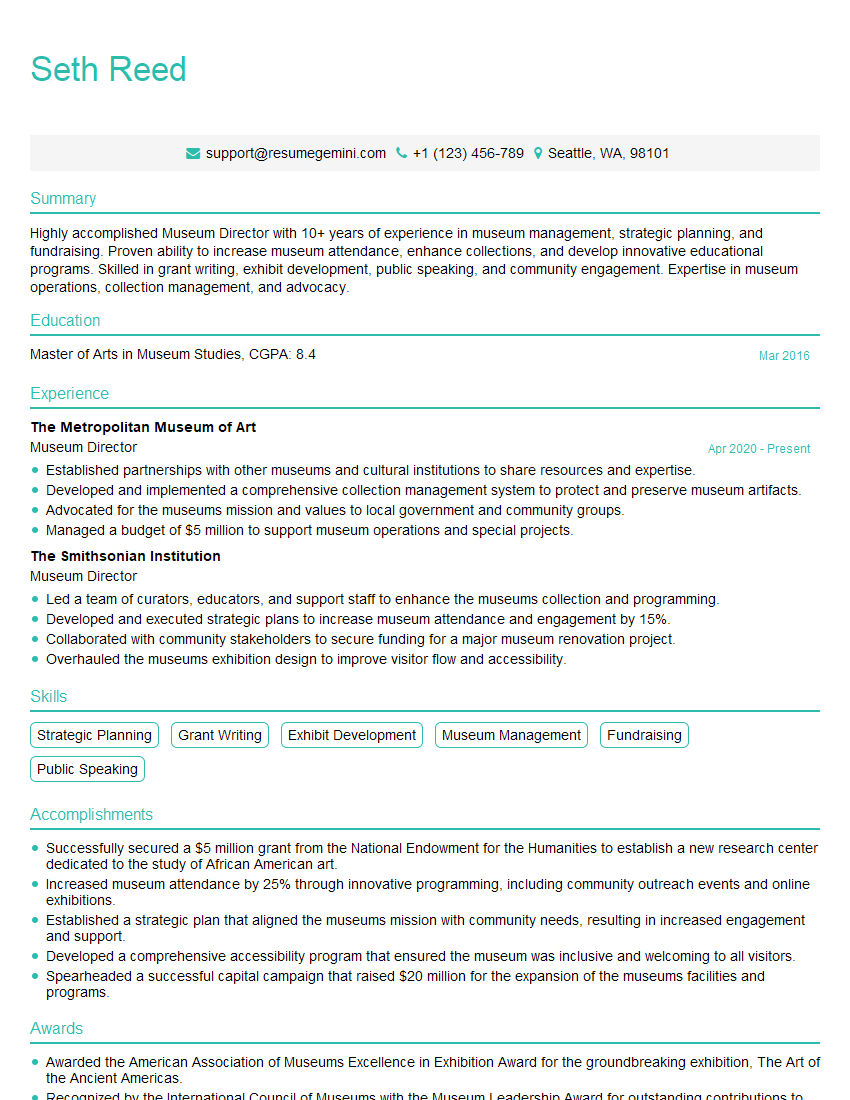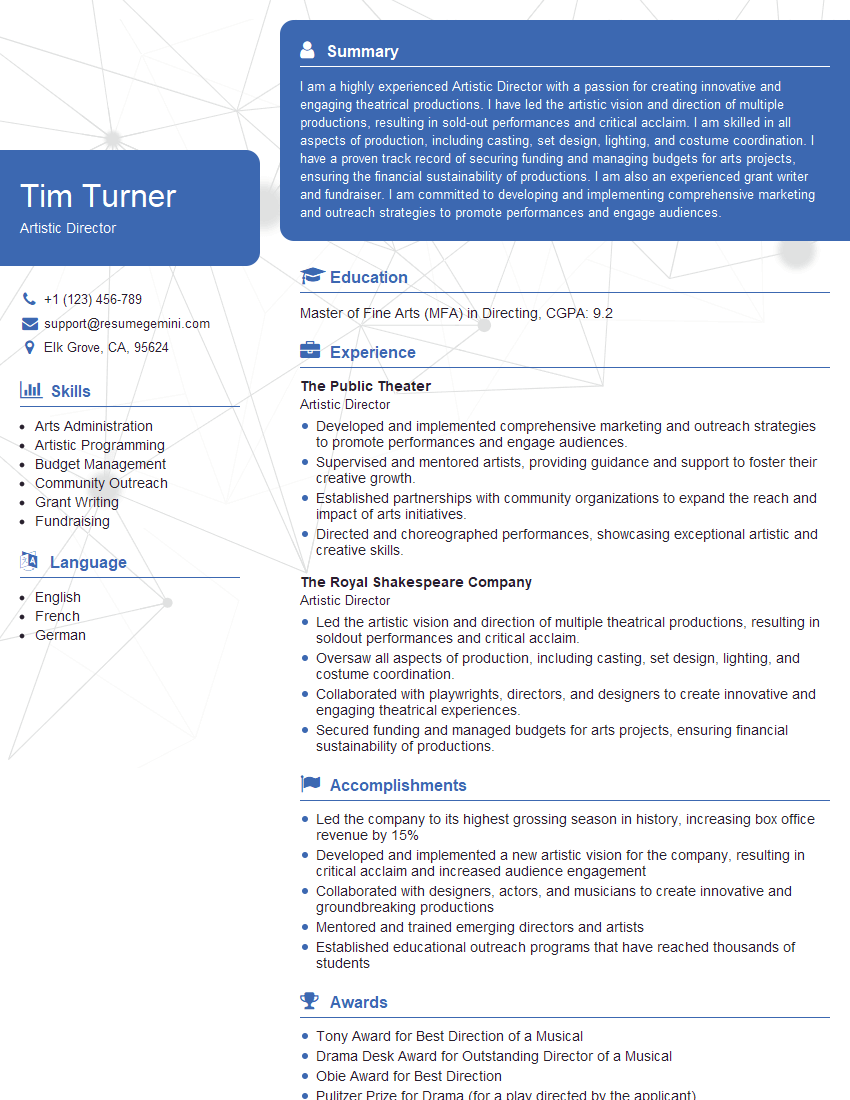Interviews are opportunities to demonstrate your expertise, and this guide is here to help you shine. Explore the essential Arts Administration Experience interview questions that employers frequently ask, paired with strategies for crafting responses that set you apart from the competition.
Questions Asked in Arts Administration Experience Interview
Q 1. Describe your experience managing budgets in a non-profit arts organization.
Managing budgets in a non-profit arts organization requires meticulous planning, forecasting, and ongoing monitoring. It’s akin to being a skilled chef, carefully balancing ingredients (funds) to create a delicious and fulfilling artistic meal. My experience includes developing and managing budgets ranging from $50,000 to $500,000 annually, encompassing program costs, administrative expenses, fundraising expenses, and capital improvements.
My approach begins with a thorough needs assessment, translating artistic vision into concrete financial requirements. This involves collaborating closely with artistic directors, program managers, and board members to establish realistic budget projections. We utilize a zero-based budgeting approach, carefully justifying every expenditure. Regular monitoring involves tracking income and expenses against the budget, identifying variances, and proactively adjusting spending to stay on track. I leverage budgeting software to streamline this process and provide timely, accurate financial reports for the board and other stakeholders.
For example, during my time at the City Arts Collective, I successfully negotiated a 15% reduction in our venue rental costs through strategic communication and leveraging existing relationships. This freed up funds that were then allocated to enhance our artist residency program.
Q 2. Explain your approach to fundraising and grant writing.
My fundraising approach is multifaceted, combining strategic grant writing with diverse individual giving and corporate sponsorship strategies. It’s like orchestrating a symphony – each instrument (funding source) plays a vital role in creating a harmonious whole. My grant writing focuses on identifying appropriate funders and crafting compelling proposals that clearly articulate the artistic merit, community impact, and financial sustainability of the organization’s projects.
I begin by researching potential funders, identifying grants that align with our organizational mission and program goals. The proposal writing process is rigorous, requiring a clear articulation of the project’s objectives, methodology, budget, and evaluation plan. I pay close attention to each funder’s guidelines and priorities, tailoring each proposal to their specific interests. For individual giving, I cultivate relationships with donors through personalized communications, cultivating a sense of community and shared purpose.
In one instance, I secured a $75,000 grant from the National Endowment for the Arts by meticulously crafting a proposal that highlighted the project’s innovative approach to community engagement and its potential to reach underserved populations. I followed up with regular updates and transparent financial reporting to maintain a strong relationship with the funder.
Q 3. How would you handle a conflict between an artist and a board member?
Conflict resolution requires a collaborative and empathetic approach, prioritizing open communication and mutual understanding. It’s like mediating a disagreement between two valued members of a team – fairness, empathy, and clear communication are crucial. My strategy involves facilitating a neutral space for both the artist and board member to express their perspectives without interruption. I actively listen to both sides, identifying the core issues and underlying concerns.
I then work to create a collaborative solution that respects the artistic vision while aligning with the organization’s values and objectives. This might involve finding compromises, mediating disagreements, or seeking the input of a neutral third party. The goal is to preserve the working relationship and foster a positive environment where artistic expression can thrive. Documentation of the conflict and the resolution is important for future reference.
For example, I once successfully mediated a conflict between an artist whose work was deemed too controversial by a board member by facilitating a conversation that explored the artistic intent and the potential for alternative presentations, leading to a mutually agreeable solution.
Q 4. What strategies would you employ to increase audience engagement?
Increasing audience engagement requires a holistic approach that considers the audience’s needs and preferences. It’s like cultivating a garden – nurturing the seeds (audience interest) and providing the right conditions for growth. My strategy involves a multi-pronged approach including diverse programming, targeted marketing, enhanced accessibility, and interactive experiences.
This includes offering a variety of programs to appeal to diverse interests, utilizing social media and email marketing to reach target audiences, ensuring accessibility for people with disabilities, and incorporating interactive elements into performances and exhibitions. Gathering audience feedback is crucial to understanding what resonates and informing future programming decisions. Data-driven decisions and audience surveys help to refine our strategies.
At the River City Theatre, I implemented a pre-show talk series that provided context and background information for the performances, significantly increasing post-show discussions and audience engagement with the themes explored in the play.
Q 5. Detail your experience with marketing and promotion of arts events.
Marketing and promotion of arts events requires a strategic approach blending traditional and digital methods. It’s akin to crafting an effective advertisement – highlighting the unique selling points while catching the attention of the target audience. My experience includes developing marketing plans that encompass press releases, social media campaigns, email marketing, website optimization, print advertising, and community outreach.
I understand the importance of creating compelling visual and textual content that effectively communicates the value proposition of the event, engaging target audiences through various channels. This includes creating visually appealing posters, brochures, and website content, targeting specific audiences through social media, optimizing the website for search engines, and engaging with the local media.
For instance, during the launch of a new exhibit, I coordinated a collaborative social media campaign involving local influencers and art bloggers, significantly increasing website traffic and event attendance.
Q 6. How do you measure the success of an arts program?
Measuring the success of an arts program necessitates a multi-faceted approach that goes beyond simple ticket sales. It’s like evaluating the success of a restaurant – not just based on the number of customers but also on factors like customer satisfaction, repeat business, and the overall experience. My approach involves collecting both quantitative and qualitative data to assess program impact.
Quantitative metrics might include audience attendance, ticket sales, website traffic, and social media engagement. Qualitative data is equally important and may be collected through audience surveys, artist feedback, and post-event reviews. The overall success is determined by a combination of these elements, reflecting the artistic merit, community impact, and financial sustainability of the program.
In one case, we evaluated a community theatre program’s success not only by its ticket sales, but also by assessing the number of community members involved, the level of audience satisfaction, and the program’s overall contribution to the local community.
Q 7. What is your experience with donor cultivation and stewardship?
Donor cultivation and stewardship are critical for the long-term sustainability of any non-profit arts organization. It’s akin to building and maintaining relationships – nurturing connections to ensure their ongoing support. My experience involves developing and implementing strategies to engage donors at all levels, from first-time givers to major philanthropists.
My approach includes personalized communication, cultivating relationships through regular contact, providing updates on the organization’s activities, recognizing donor contributions, and offering exclusive opportunities for donor engagement. This might involve creating recognition programs, hosting donor events, providing behind-the-scenes access, and offering personalized thank-you notes. Tracking and reporting on donor contributions and interactions is important to demonstrate the impact of philanthropy and foster a strong relationship of trust.
I once successfully increased major gift contributions by 20% by implementing a comprehensive donor stewardship program, focused on building lasting relationships through regular communication and personalized recognition.
Q 8. Describe your experience with event planning and management.
Event planning and management in the arts requires a meticulous approach, blending creative vision with logistical precision. It’s not just about booking a venue; it’s about crafting an experience. My experience encompasses all phases, from initial concept development and budget allocation to on-site execution and post-event analysis.
- Concept Development: For a recent exhibition launch, I collaborated with the artist and curator to define the event’s goals, target audience, and overall tone. This involved brainstorming creative elements, selecting appropriate artwork, and determining the optimal venue size and ambiance.
- Budget Management: I developed a detailed budget, securing sponsorships, negotiating vendor contracts, and tracking expenses meticulously. This often involves creative solutions like bartering services or leveraging in-kind donations.
- Logistics & Execution: This included securing permits, coordinating catering and security, managing volunteers, overseeing marketing and publicity, and ensuring smooth guest registration and flow. For a large-scale outdoor performance, this meant detailed site mapping, risk assessment, and contingency planning for weather-related issues.
- Post-Event Analysis: Following each event, I conduct a thorough review, analyzing attendance figures, audience feedback, and financial performance. This data informs future planning and helps identify areas for improvement. For example, analyzing post-event surveys from a concert helped us understand audience preferences for future events and fine-tune the program.
Q 9. Explain your understanding of copyright and intellectual property in the arts.
Copyright and intellectual property (IP) are crucial in the arts. Understanding these legal frameworks is paramount for protecting artists’ rights and ensuring ethical practices within organizations. Copyright protects original works of authorship, including visual arts, music, literature, and performance. Intellectual property is a broader term encompassing copyrights, patents, trademarks, and trade secrets.
In my experience, this involves:
- Licensing Agreements: Negotiating and securing appropriate licenses for the use of copyrighted material in exhibitions, performances, or publications. This ensures compliance and protects the organization from potential infringement.
- Copyright Registration: Advising artists on the importance of registering their works with the relevant copyright office to establish clear ownership and facilitate legal action if necessary.
- Attribution and Acknowledgement: Ensuring proper attribution to artists and copyright holders in all promotional materials and program notes. This is crucial for ethical practice and maintaining strong relationships with artists.
- Fair Use Doctrine: Understanding the limitations and exceptions of copyright law, particularly regarding ‘fair use’. This involves determining when it’s permissible to use copyrighted material without explicit permission, always within legal boundaries.
Q 10. How would you handle a crisis situation, such as negative press or a budget shortfall?
Crisis management in arts administration requires quick thinking, decisive action, and clear communication. My approach involves a structured framework:
- Assess the Situation: Immediately gather all relevant information to understand the scope and severity of the crisis. This might involve reviewing news articles, social media posts, or speaking with affected individuals.
- Develop a Communication Plan: Create a message that addresses the crisis honestly and transparently. This often requires preparing statements for the media and internal stakeholders.
- Take Corrective Action: Implement measures to mitigate the damage. This could involve issuing a public apology, taking disciplinary action, or launching an internal investigation. In the case of a budget shortfall, immediate cost-saving measures would be prioritized, including exploring alternative funding sources.
- Monitor the Situation: Continuously track the crisis’s progression, adjust the response plan as needed, and carefully monitor public and stakeholder reactions.
- Conduct a Post-Mortem: After the crisis has subsided, a thorough review identifies lessons learned and helps to develop improved crisis management protocols for the future. This could involve evaluating the effectiveness of our communication strategies and identifying areas for improvement.
For instance, during a period of negative press surrounding a controversial artwork, we proactively engaged with critics, clarifying the artist’s intentions and engaging in respectful dialogue.
Q 11. What is your experience with board relations and governance?
Board relations and governance are fundamental to effective arts administration. My experience includes fostering strong relationships with board members, facilitating effective communication, and ensuring the organization adheres to its governance structure.
- Board Meetings: Preparing comprehensive agendas, distributing timely materials, and facilitating productive discussions. This includes effectively conveying complex financial information and strategic plans to non-experts.
- Committee Work: Supporting the work of various board committees, such as finance, fundraising, and program committees. This ensures efficient functioning and effective decision-making.
- Relationship Building: Nurturing positive relationships with board members through regular communication, feedback sessions, and social events. This cultivates trust and encourages active engagement.
- Strategic Planning: Collaborating with the board to develop and implement long-term strategic plans, aligning the organization’s goals with the board’s vision.
- Compliance: Ensuring the board’s actions and decisions adhere to all relevant legal and ethical guidelines.
Q 12. Describe your experience with financial reporting and compliance.
Financial reporting and compliance are critical for the stability and sustainability of any arts organization. My experience involves managing budgets, preparing financial statements, and ensuring compliance with all relevant regulations.
- Budget Development & Management: Creating and monitoring detailed budgets, forecasting revenue and expenses, and managing cash flow effectively. This involved utilizing budgeting software and presenting financial information to the board.
- Financial Reporting: Preparing accurate and timely financial statements, including income statements, balance sheets, and cash flow statements, in accordance with generally accepted accounting principles (GAAP).
- Grant Writing & Reporting: Writing successful grant proposals and submitting timely and accurate grant reports to funding agencies. This requires meticulous documentation and adherence to reporting guidelines.
- Audits: Collaborating with auditors to ensure the organization’s financial records are accurate and compliant. This involves preparing all necessary documentation and responding to audit queries.
- Compliance: Ensuring adherence to all relevant tax laws and regulations. This includes maintaining proper records, filing timely tax returns, and adhering to all relevant reporting requirements.
Q 13. How do you stay current with trends in the arts industry?
Staying current with trends in the arts industry is crucial for remaining relevant and competitive. My approach involves a multi-faceted strategy:
- Industry Publications: Regularly reading industry publications, such as The Art Newspaper, American Theatre, and relevant professional journals, to stay informed about current events, best practices, and emerging trends.
- Conferences & Workshops: Attending professional conferences and workshops to network with peers, learn from experts, and expand my knowledge of new technologies and approaches.
- Online Resources: Utilizing online resources, such as arts-related websites, blogs, and social media groups, to access the latest news, research, and industry insights.
- Networking: Actively engaging in networking events and professional organizations to build relationships with colleagues and learn about their experiences and challenges.
- Data Analysis: Tracking attendance figures, audience demographics, and feedback to understand evolving artistic preferences and consumer behavior.
Q 14. What is your approach to building relationships with community stakeholders?
Building strong relationships with community stakeholders is essential for the success of any arts organization. My approach is based on mutual respect, open communication, and a commitment to collaboration.
- Community Engagement: Participating in community events and initiatives to increase visibility and foster positive relationships with local residents and businesses. This could involve sponsoring local events or offering outreach programs.
- Collaboration: Seeking out opportunities for collaboration with other community organizations, such as schools, libraries, and local businesses. This fosters a sense of shared purpose and creates mutually beneficial partnerships.
- Accessibility: Making arts programs and events accessible to all members of the community, regardless of their background or socioeconomic status. This might involve offering discounted tickets, providing transportation assistance, or adapting programs for diverse audiences.
- Communication: Maintaining open communication with community members through newsletters, social media, and community forums. This keeps stakeholders informed about our activities and encourages their participation.
- Feedback: Actively soliciting and responding to feedback from community members to ensure our programs and services meet their needs and expectations. This could involve hosting community forums or conducting surveys.
Q 15. Describe your experience with personnel management.
Personnel management in arts administration involves overseeing all aspects of an organization’s human resources, from recruitment and hiring to performance evaluations and terminations. It requires a blend of strong leadership, empathy, and a deep understanding of employment law. My experience encompasses all these facets. For instance, at the City Symphony Orchestra, I was responsible for managing a team of 30, including musicians, administrative staff, and marketing personnel. This involved creating and implementing performance management systems, conducting regular employee reviews, and addressing employee concerns. I also managed the recruitment process, ensuring we attracted highly qualified candidates through targeted advertising and networking within the industry. Furthermore, I successfully negotiated union contracts, ensuring fair compensation and benefits for our musicians while remaining fiscally responsible to the organization.
I believe effective personnel management involves fostering a positive and productive work environment, promoting open communication, and providing opportunities for professional development. This approach not only leads to a happier and more engaged workforce but also enhances overall organizational performance.
Career Expert Tips:
- Ace those interviews! Prepare effectively by reviewing the Top 50 Most Common Interview Questions on ResumeGemini.
- Navigate your job search with confidence! Explore a wide range of Career Tips on ResumeGemini. Learn about common challenges and recommendations to overcome them.
- Craft the perfect resume! Master the Art of Resume Writing with ResumeGemini’s guide. Showcase your unique qualifications and achievements effectively.
- Don’t miss out on holiday savings! Build your dream resume with ResumeGemini’s ATS optimized templates.
Q 16. How would you develop and implement a strategic plan for an arts organization?
Developing a strategic plan for an arts organization requires a thorough understanding of its mission, vision, and current state. I approach this through a five-step process.
- Step 1: Assessment: This phase involves conducting a SWOT analysis (Strengths, Weaknesses, Opportunities, Threats) to evaluate the organization’s internal capabilities and the external environment. This includes market research, audience analysis, and a review of financial statements.
- Step 2: Goal Setting: Based on the assessment, we establish SMART (Specific, Measurable, Achievable, Relevant, Time-bound) goals. These might include increasing audience engagement, expanding fundraising efforts, or developing new artistic programs.
- Step 3: Strategy Development: This involves identifying specific strategies to achieve the goals. For example, a goal to increase audience engagement might involve implementing a social media marketing campaign and developing family-friendly programming.
- Step 4: Implementation: This phase focuses on putting the strategies into action. This requires creating timelines, assigning responsibilities, and securing necessary resources.
- Step 5: Evaluation: Regularly evaluating progress against the established goals is crucial. This might involve monitoring website traffic, tracking ticket sales, or conducting audience surveys. Adjustments are made as needed.
For example, during my time at the City Theatre, I led the development of a five-year strategic plan that resulted in a 25% increase in audience attendance and a 15% increase in fundraising revenue.
Q 17. What is your understanding of accessibility and inclusion in the arts?
Accessibility and inclusion in the arts are paramount. It means ensuring that arts and cultural experiences are available and enjoyable to all members of the community, regardless of their abilities, backgrounds, or socioeconomic status. This includes physical accessibility (wheelchair ramps, audio descriptions, sign language interpretation), economic accessibility (affordable ticket prices, scholarship programs), and cultural accessibility (programming that reflects the diversity of the community).
My approach emphasizes proactively designing programs and facilities to be inclusive from the outset. This might involve consulting with disability organizations, employing diverse artists and staff, and offering diverse programming that resonates with various cultural groups. A successful example involved working with the community center to make our theater performances accessible to deaf and hard-of-hearing audiences via live captioning and sign language interpreters, significantly broadening our audience reach.
Q 18. Describe your experience with contract negotiation.
Contract negotiation is a critical skill in arts administration, involving securing favorable terms for both the organization and its partners. This includes artists, venues, sponsors, and vendors. My experience encompasses negotiating a wide array of contracts, from artist performance agreements to venue rental agreements and sponsorship deals. I approach negotiations strategically, preparing thoroughly by researching market rates and understanding the needs and priorities of all parties involved.
I always aim for mutually beneficial outcomes. For example, while negotiating a contract with a renowned artist, I successfully secured a reduced performance fee in exchange for promotional opportunities and a percentage of ticket sales, benefiting both the artist and the organization.
Q 19. How would you create a diverse and equitable workplace environment?
Creating a diverse and equitable workplace involves fostering an environment where all employees feel valued, respected, and have equal opportunities for advancement. This requires a multi-faceted approach.
- Recruitment: Implement inclusive recruitment strategies that reach diverse talent pools.
- Training: Provide diversity and inclusion training to raise awareness and promote understanding.
- Compensation and Benefits: Ensure fair and equitable compensation and benefits packages.
- Mentorship Programs: Create opportunities for mentorship and sponsorship of employees from underrepresented groups.
- Employee Resource Groups: Support the formation of employee resource groups to foster community and support.
- Policies: Develop clear and robust policies that address discrimination and harassment.
At the museum where I worked, we implemented a blind resume screening process to eliminate unconscious bias in hiring, resulting in a more diverse workforce.
Q 20. What is your experience with using data to inform decision-making?
Data-driven decision making is essential for effective arts administration. I regularly use data analysis to inform strategic planning, fundraising, marketing, and program evaluation. This involves collecting and analyzing various data points, such as website traffic, social media engagement, ticket sales, audience demographics, and fundraising results.
For instance, by analyzing website analytics, I identified that our online marketing efforts were more effective when targeting a specific demographic. This allowed us to allocate marketing resources more efficiently. In another case, audience demographic data helped us tailor programming to better resonate with different segments of the community.
Q 21. Describe a time you had to make a difficult decision in arts administration.
One of the most difficult decisions I had to make involved budget cuts. Due to unexpected funding shortfalls, I was forced to make significant reductions in our operating budget. This required careful consideration of program priorities and potential impact on staff. The process involved extensive analysis of various program costs and benefits, stakeholder consultation, and ultimately, difficult personnel decisions. While painful, I approached the process transparently and ethically, ensuring fair treatment and support for affected employees. The result, though difficult, ultimately allowed the organization to remain financially solvent and continue providing high-quality arts programs.
Q 22. How do you manage competing priorities in a fast-paced environment?
Managing competing priorities in a fast-paced arts environment requires a strategic approach. It’s like conducting an orchestra – each instrument (project, task, deadline) needs attention, but the conductor (me) must ensure harmony and a successful performance. My method involves a three-pronged strategy: prioritization, delegation, and time-blocking.
Prioritization: I use a system like Eisenhower Matrix (urgent/important) to categorize tasks. This helps me focus on high-impact activities first and delegate or postpone less critical ones. For instance, securing a major grant might be categorized as urgent and important, while updating the organization’s social media presence might be important but less urgent.
Delegation: I’m adept at identifying tasks suitable for team members based on their skills and workload. Trusting my team is vital. For example, I might delegate the creation of marketing materials to the communications officer while focusing on securing fundraising.
Time-blocking: I allocate specific time slots for various tasks in my calendar, treating them like appointments. This minimizes distractions and promotes focused work. For example, I might block out two hours on Tuesday morning specifically for grant writing.
Q 23. What software or technologies are you proficient in for arts administration?
Proficiency in relevant software is crucial for efficient arts administration. My skillset includes a range of tools designed for managing various aspects of arts organizations. I’m proficient in:
Customer Relationship Management (CRM) systems: Such as Salesforce or Tessitura, for managing donor relationships, ticketing, and fundraising.
Spreadsheet software: Microsoft Excel or Google Sheets for budget management, data analysis, and reporting.
Project management software: Asana, Trello, or Monday.com to manage projects, track progress, and collaborate with teams.
Financial software: QuickBooks or Xero for accounting and financial reporting.
Graphic design software: Adobe Photoshop or Canva for creating marketing materials and visual communication.
Furthermore, I’m comfortable learning and adapting to new technologies as needed. The arts world is constantly evolving, and I embrace that change.
Q 24. How do you ensure compliance with relevant regulations and laws?
Compliance is paramount in arts administration. This involves adhering to a variety of regulations, including tax laws, employment laws, copyright laws, and accessibility regulations. My approach involves proactive measures and ongoing vigilance:
Regular Training: I stay updated on relevant regulations through workshops, online resources, and professional development opportunities. This ensures I remain informed about changes and best practices.
Internal Policies and Procedures: I contribute to the development and implementation of clear internal policies and procedures to ensure compliance across all areas of the organization. This includes policies related to data privacy, fundraising ethics, and employment practices.
External Audits and Reviews: I collaborate with external auditors to conduct regular reviews to identify potential compliance gaps and ensure that all our practices are above board.
Documentation: Meticulous record-keeping is essential. I ensure proper documentation of all financial transactions, contracts, and employee records to facilitate audits and demonstrate compliance.
Essentially, I view compliance not as a burden, but as a crucial aspect of responsible and ethical management.
Q 25. What is your experience with evaluating the effectiveness of arts education programs?
Evaluating arts education programs requires a multi-faceted approach combining quantitative and qualitative data. I’ve been involved in evaluating programs using various methodologies.
Pre and Post-Tests: Assessing students’ skills and knowledge before and after the program to measure improvements in technical skills and understanding.
Surveys and Questionnaires: Gathering feedback from students, teachers, and parents to assess satisfaction, engagement, and perceived impact.
Observations and Case Studies: Direct observation of classes and interactions to capture qualitative data on teaching methods, student participation, and overall learning environment.
Portfolio Reviews: Evaluating students’ work samples to demonstrate growth in creativity, technical proficiency, and artistic expression. This might include analyzing student artwork, musical performances, or theatrical productions.
The goal is to not just measure participation but to understand the impact on student learning, artistic growth, and overall development. Using these assessment methods to measure the effectiveness of an arts education program allows for iterative improvement and ensures that the program continues to meet its educational goals.
Q 26. Describe your experience with developing and managing partnerships.
Developing and managing partnerships is crucial for success in the arts. I have experience building collaborative relationships with diverse stakeholders, including corporations, foundations, government agencies, schools, and other non-profit organizations.
Needs Assessment: I begin by identifying mutual goals and needs. For example, a partnership with a local school might involve providing after-school arts programs while gaining access to a new audience.
Relationship Building: Establishing trust and open communication is key. This requires actively listening to the partner’s perspectives and addressing their concerns.
Contract Negotiation: Formalizing agreements outlining roles, responsibilities, and expectations to ensure clarity and accountability.
Communication and Collaboration: Regular meetings, progress reports, and shared resources are crucial for maintaining momentum and addressing potential challenges.
Evaluation and Sustainability: Assessing the effectiveness of the partnership and making adjustments as needed to ensure long-term success. This might involve tracking program participation, measuring financial outcomes, and conducting feedback sessions.
For example, I successfully secured a partnership with a local bank to sponsor a summer arts camp, resulting in increased funding and community outreach. This required understanding both the bank’s branding goals and our organization’s programmatic needs.
Q 27. Explain your understanding of risk management in an arts organization.
Risk management in an arts organization encompasses identifying, assessing, and mitigating potential threats to its operations, reputation, and financial stability. This might include risks related to finances, legal issues, safety, and reputation. My approach involves a structured process:
Risk Identification: This involves brainstorming potential risks, considering factors like past incidents, industry trends, and the organization’s specific context. For instance, a potential risk might be a drop in ticket sales due to competition or a negative review affecting public perception.
Risk Assessment: Evaluating the likelihood and impact of each identified risk. This helps prioritize the most pressing concerns. We use a matrix that considers both probability and impact.
Risk Response Planning: Developing strategies to mitigate identified risks. This could include purchasing insurance, implementing safety protocols, creating crisis communication plans, or diversifying funding sources. For example, we created an emergency plan outlining steps to take in case of power outages or severe weather.
Monitoring and Review: Regularly reviewing and updating the risk management plan to reflect changing circumstances and emerging risks.
Proactive risk management enhances an organization’s resilience and sustainability, ensuring that it can navigate unexpected challenges and continue fulfilling its mission.
Q 28. How would you leverage social media to promote arts programs?
Leveraging social media effectively requires a strategic approach tailored to the specific organization and its programs. It’s not simply about posting announcements; it’s about building a community and engaging with potential audiences.
Platform Selection: Identifying the platforms most relevant to the target audience (e.g., Instagram for visually-focused arts, Facebook for broader reach, TikTok for younger demographics).
Content Strategy: Creating a mix of content formats, including photos, videos, behind-the-scenes glimpses, artist spotlights, event announcements, and interactive polls. This keeps the content fresh and engaging.
Community Engagement: Responding promptly to comments and messages, initiating conversations, and fostering a sense of community among followers. Run contests or Q&As to boost engagement.
Advertising and Promotion: Utilizing paid advertising on platforms to extend reach and target specific demographics, especially for events or fundraising campaigns.
Analytics and Measurement: Tracking key metrics (e.g., engagement, reach, website traffic) to evaluate the effectiveness of social media strategies and make data-driven adjustments.
For instance, I’ve used Instagram to showcase artist interviews, behind-the-scenes photos of rehearsals, and snippets of performances, creating a vibrant online presence that drives ticket sales and fosters a connection with our audience.
Key Topics to Learn for Arts Administration Experience Interview
- Budget Management & Fundraising: Understanding budgeting principles, grant writing, fundraising strategies, and donor relations within the arts context.
- Marketing & Communications: Developing and implementing marketing plans, utilizing social media effectively, managing public relations, and crafting compelling promotional materials for arts events and programs.
- Project Management: Planning, executing, and evaluating arts projects, from initial concept to completion, while managing timelines, resources, and teams.
- Artistic Programming & Curatorial Practices: Understanding the selection and presentation of artistic works, working with artists, and developing engaging programming that aligns with organizational mission and audience needs.
- Human Resources & Team Management: Managing staff and volunteers, fostering a positive work environment, and addressing personnel issues within the unique dynamics of arts organizations.
- Legal & Ethical Considerations: Navigating copyright laws, contracts, and ethical dilemmas related to arts administration and artistic practice.
- Data Analysis & Reporting: Collecting, analyzing, and presenting data to demonstrate the impact of arts programs and justify funding requests.
- Audience Engagement & Development: Strategies for building and maintaining strong relationships with audiences, fostering community engagement, and increasing audience participation.
- Technology & Digital Platforms: Utilizing digital tools for ticketing, marketing, communication, and managing artistic assets.
Next Steps
Mastering Arts Administration skills is crucial for career advancement in this dynamic field. A strong understanding of these areas will significantly enhance your interview performance and open doors to exciting opportunities. To maximize your job prospects, create an ATS-friendly resume that highlights your achievements and skills effectively. We recommend using ResumeGemini, a trusted resource for building professional resumes that stand out. ResumeGemini provides examples of resumes tailored to Arts Administration Experience, ensuring your application showcases your qualifications in the best possible light.
Explore more articles
Users Rating of Our Blogs
Share Your Experience
We value your feedback! Please rate our content and share your thoughts (optional).
What Readers Say About Our Blog
Hello,
We found issues with your domain’s email setup that may be sending your messages to spam or blocking them completely. InboxShield Mini shows you how to fix it in minutes — no tech skills required.
Scan your domain now for details: https://inboxshield-mini.com/
— Adam @ InboxShield Mini
Reply STOP to unsubscribe
Hi, are you owner of interviewgemini.com? What if I told you I could help you find extra time in your schedule, reconnect with leads you didn’t even realize you missed, and bring in more “I want to work with you” conversations, without increasing your ad spend or hiring a full-time employee?
All with a flexible, budget-friendly service that could easily pay for itself. Sounds good?
Would it be nice to jump on a quick 10-minute call so I can show you exactly how we make this work?
Best,
Hapei
Marketing Director
Hey, I know you’re the owner of interviewgemini.com. I’ll be quick.
Fundraising for your business is tough and time-consuming. We make it easier by guaranteeing two private investor meetings each month, for six months. No demos, no pitch events – just direct introductions to active investors matched to your startup.
If youR17;re raising, this could help you build real momentum. Want me to send more info?
Hi, I represent an SEO company that specialises in getting you AI citations and higher rankings on Google. I’d like to offer you a 100% free SEO audit for your website. Would you be interested?
Hi, I represent an SEO company that specialises in getting you AI citations and higher rankings on Google. I’d like to offer you a 100% free SEO audit for your website. Would you be interested?
good
